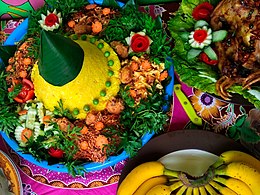
Back মালয় রন্ধনশৈলী Bengali/Bangla آشپزی مالایی Persian Cuisine malaise French Hidangan Melayu ID Olahan Malay JV 말레이 요리 Korean Masakan Melayu Malay Kuchnia malajska Polish Малайська кухня Ukrainian مالائی پکوان Urdu

 |
| This article is part of the series on |
| Indonesian cuisine Masakan Indonesia |
|---|
|
|
 |
| This article is part of the series on |
| Malaysian cuisine Masakan Malaysia |
|---|
|
|
Malay cuisine is the traditional food of the ethnic Malays of Southeast Asia, residing in modern-day Malaysia, Indonesia (parts of Sumatra and Kalimantan), Singapore, Brunei, Southern Thailand and the Philippines (mostly southern) as well as Cocos Islands, Christmas Island, Sri Lanka and South Africa.
The main characteristic of traditional Malay cuisine is the generous use of spices. Coconut milk is also important in giving Malay dishes their rich, creamy character. The other foundation is belacan (prawn paste), which is used as a base for sambal, a rich sauce or condiment made from belacan, chilli peppers, onions and garlic. Malay cooking also makes plentiful use of lemongrass and galangal.[1]
Nearly every Malay meal is served with rice, which is also the staple food in many other Asian cultures. Although there are various types of dishes in a Malay meal, all are served at once, not in courses. A typical meal consists of a plate of rice for each person on the table. Dishes are meant to be shared among the diners and each dish is provided with a spoon. The diner proceeds to spoon the dishes of his choosing onto his rice plate. Food is eaten delicately with the fingers of the right hand, never with the left which is used for personal ablutions, and Malays rarely use utensils.[2]
- ^ James Alexander (2006). Malaysia Brunei & Singapore. New Holland Publishers. p. 58. ISBN 1-86011-309-5.
- ^ World and Its Peoples: Malaysia, Philippines, Singapore, and Brunei. New York: Marshall Cavendish Corporation. 2008. p. 1222.
© MMXXIII Rich X Search. We shall prevail. All rights reserved. Rich X Search